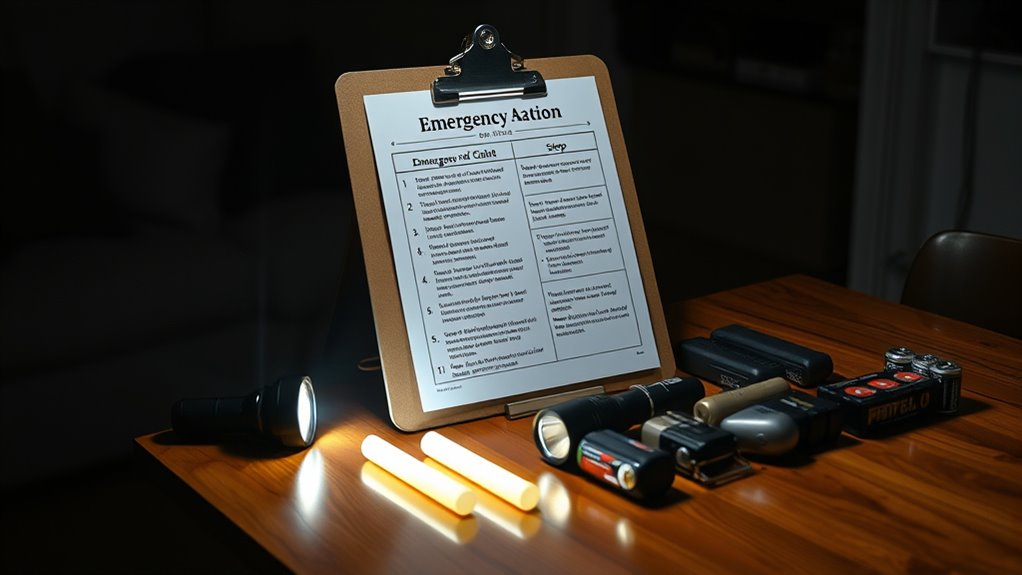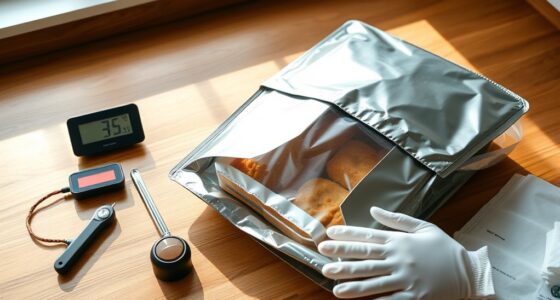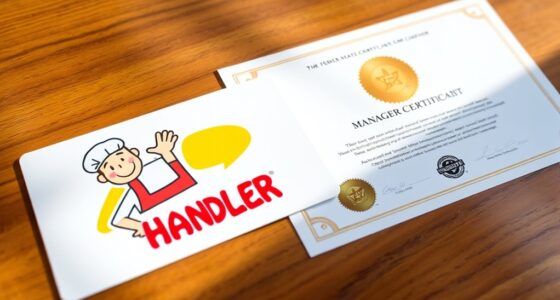To create an effective emergency action plan for power outages, you should first assess your household or business power needs by listing essential devices and calculating their wattage. Develop a clear communication plan with emergency contacts, and prepare an emergency kit with supplies like water, food, and a portable charger. Safeguard critical items, establish safety protocols, and coordinate with utility providers. Conduct regular drills to make sure you’re prepared—if you want detailed steps, keep exploring below.
Key Takeaways
- Develop comprehensive emergency action plans including communication, safety protocols, and backup power strategies.
- Conduct regular drills simulating power outage scenarios to test response times and identify weaknesses.
- Assign clear roles and responsibilities to staff, ensuring everyone understands procedures during outages.
- Maintain updated contact lists for utility providers, emergency services, and vulnerable populations.
- Review and update plans periodically to incorporate lessons learned, new technology, and evolving safety measures.
Assessing Your Household or Business Power Needs
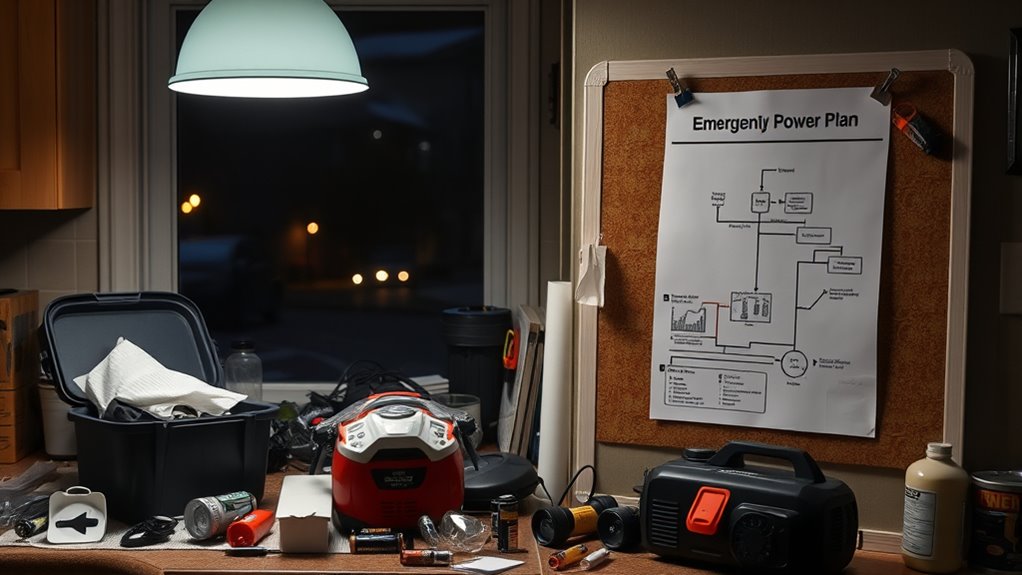
How do you determine the power requirements for your household or business during an outage? Start by listing essential devices and appliances, like refrigerators, medical equipment, lights, and communication devices. Check each item’s wattage, usually found on labels or in manuals, and add them up to find your total power needs. Consider running some devices simultaneously, such as lights and a refrigerator, to get a realistic estimate. Think about the duration you’ll need backup power—longer outages require higher capacity. Don’t forget to include any future needs, like additional appliances or equipment. This process helps you choose the right generator size, ensuring you have enough power without overloading your system. Accurately assessing your power needs keeps your essentials running smoothly during outages.
Creating a Communication Plan for Emergency Contacts
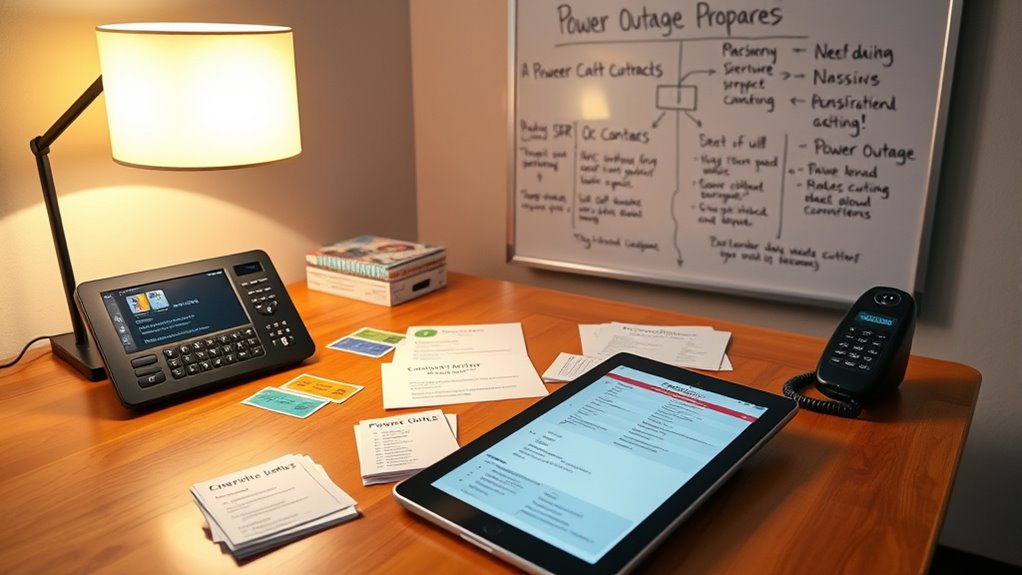
Having a clear communication plan guarantees you can quickly connect with emergency contacts during a power outage. Start by updating your contact list with everyone you might need—family, friends, neighbors, and local emergency services. Share your plan with those contacts so they know how to reach you and what steps to take. Establish multiple ways to communicate, such as texts, phone calls, or social media, in case one method fails. Keep contact information in a visible, accessible location. Practice your plan regularly to ensure everyone understands their roles. Incorporate emergency communication methods to enhance your preparedness.
Preparing an Emergency Kit for Power Outages

To stay prepared during a power outage, you need an emergency kit with essential items like water, batteries, and first aid supplies. You should also know safe food storage tips to prevent spoilage and plan for reliable power backup solutions. Having these elements ready guarantees you can handle unexpected outages safely and efficiently. Additionally, considering grocery savings strategies can help you stock up on necessary supplies cost-effectively.
Essential Items to Pack
Preparing an emergency kit for a power outage guarantees you’re equipped to handle unexpected disruptions safely and comfortably. To stay prepared, pack essential items that will support your basic needs. First, include bottled water and non-perishable snacks to stay nourished and hydrated. Second, add a flashlight with extra batteries to guarantee visibility during outages. Third, pack a fully charged portable phone charger to keep communication lines open. Lastly, include basic first aid supplies, such as bandages and antiseptic wipes, to address minor injuries. These items help you stay safe and comfortable while managing the inconvenience of a power outage. Additionally, consider sustainable and eco-friendly options when selecting supplies to minimize environmental impact. Keep your kit in an accessible location, and review it regularly to verify everything remains in working order. Staying prepared minimizes stress and keeps you safe during emergencies.
Safe Food Storage Tips
Storing food properly during a power outage helps prevent spoilage and keeps your family safe. Keep your refrigerator and freezer doors closed as much as possible to maintain cold temperatures. If you have a cooler, pack it with ice to keep perishables fresh longer. Use a thermometer to monitor internal temperatures, aiming for 40°F (4°C) or below in the fridge and 0°F (-18°C) in the freezer. Here’s a quick guide for storing foods:
| Food Type | Storage Tips | Duration |
|---|---|---|
| Dairy & Eggs | Keep refrigerated; avoid opening often | 1-2 days in fridge, longer in freezer |
| Meat & Poultry | Store in the coldest part, in airtight containers | 1-2 days in fridge, longer frozen |
| Fruits & Veggies | Use moisture-proof containers | 1-3 days in fridge |
Proper storage minimizes waste and keeps food safe during outages. Additionally, consider shower options like a Best Modern Toilet to maintain hygiene if water supply is affected.
Power Backup Solutions
Having an emergency kit ready is essential for staying safe during power outages. A well-prepared kit ensures you have the essentials to stay comfortable and safe until power is restored. Start with a portable power source, like a battery-operated generator or power bank, to keep critical devices running. Include LED flashlights and extra batteries for reliable lighting. Don’t forget a supply of non-perishable food and bottled water to sustain your household. Additionally, consider having a car charger for your phone and a basic first aid kit. This setup helps you stay connected, safe, and comfortable during outages. Being prepared with these backup solutions reduces stress and keeps your family safe until normal power is restored. Ensuring your power backup solutions are reliable can significantly improve your safety during emergencies.
Safeguarding Perishable Food and Medications
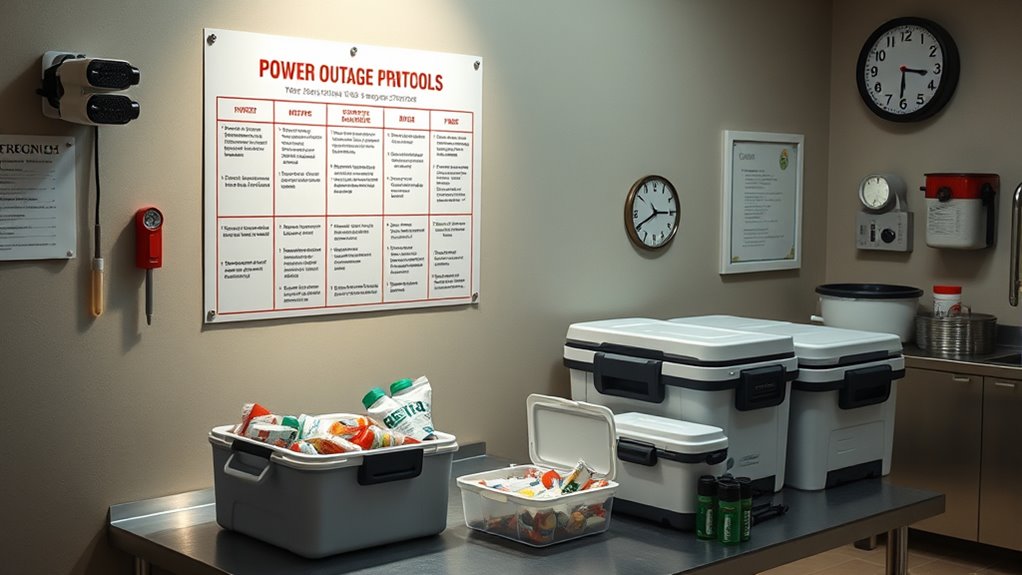
Have you ever wondered how to keep your perishable food and medications safe during a power outage? First, keep your refrigerator and freezer doors closed as much as possible to maintain cool temperatures. A full freezer stays cold longer than an empty one, so fill empty space with ice packs or bottled water. Use a thermometer to monitor temperature levels; perishable food should stay below 40°F, and medications requiring refrigeration should be kept at their recommended temperature. If the power is out for more than a day, consider transferring medications to a cooler with ice packs. Stay informed about the outage’s progress through alerts, and plan to use or discard perishable items if safe storage isn’t possible. Proper handling prevents spoilage and keeps you and your family safe. Additionally, understanding cultural impact and how technology influences our daily routines can help you adapt more effectively during extended outages.
Developing a Backup Power Strategy
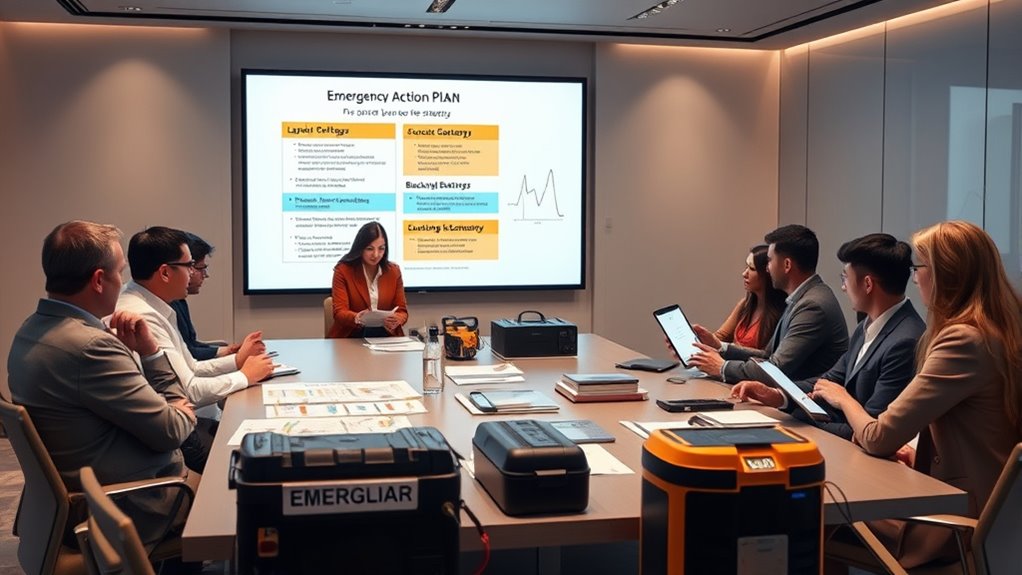
Creating a backup power strategy guarantees you can maintain essential functions during an outage. Start by evaluating your power needs, identifying critical devices like medical equipment, refrigeration, or communication tools. Then, consider your options, such as portable generators, uninterruptible power supplies (UPS), or solar backup systems. Ensure you understand the capacity and limitations of each solution before investing. Regularly test your backup systems to confirm they work when needed. Keep fuel, batteries, or maintenance supplies on hand, and develop a clear plan for startup and shutdown. Planning ahead minimizes disruptions and keeps your essential operations running smoothly. Additionally, understanding the power requirements of your devices helps in selecting the most effective backup system.
Securing Important Documents and Data
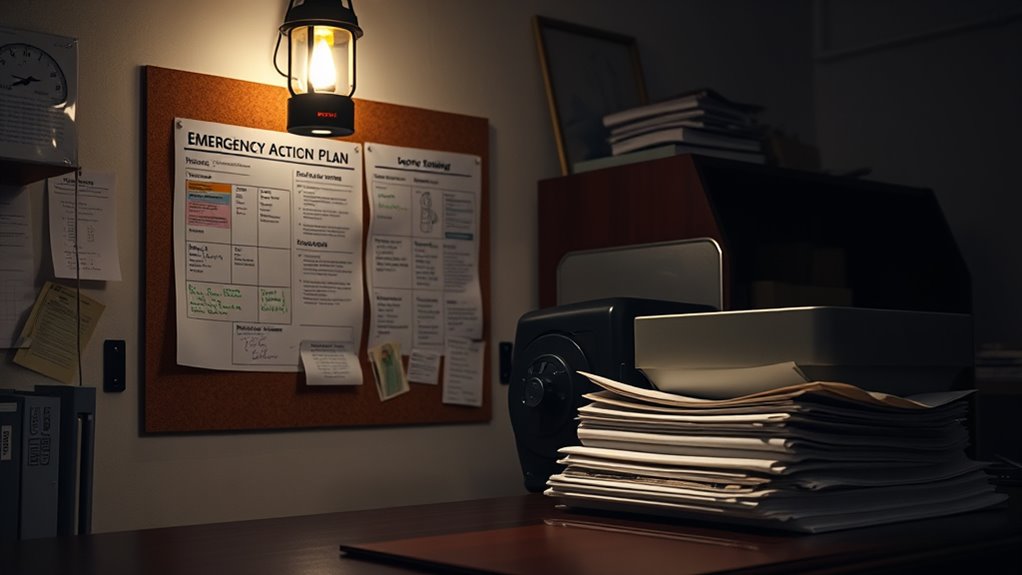
Protecting your important documents and data is crucial to prevent loss or unauthorized access during a power outage. Start by backing up digital files to a secure cloud service or external drive that isn’t affected by power disruptions. Make physical copies of critical documents like IDs, insurance policies, and financial records, and store them in a fireproof, waterproof safe. If you have sensitive information, consider encrypting digital files for added security. Keep a list of essential documents and their locations, so you can quickly access them if needed. Regularly update your backups and review your storage methods. Additionally, understanding data privacy challenges can help you implement better security measures for your stored information. Taking these steps ensures your vital information remains safe and accessible, even when power is out.
Establishing Safety Protocols During Power Loss
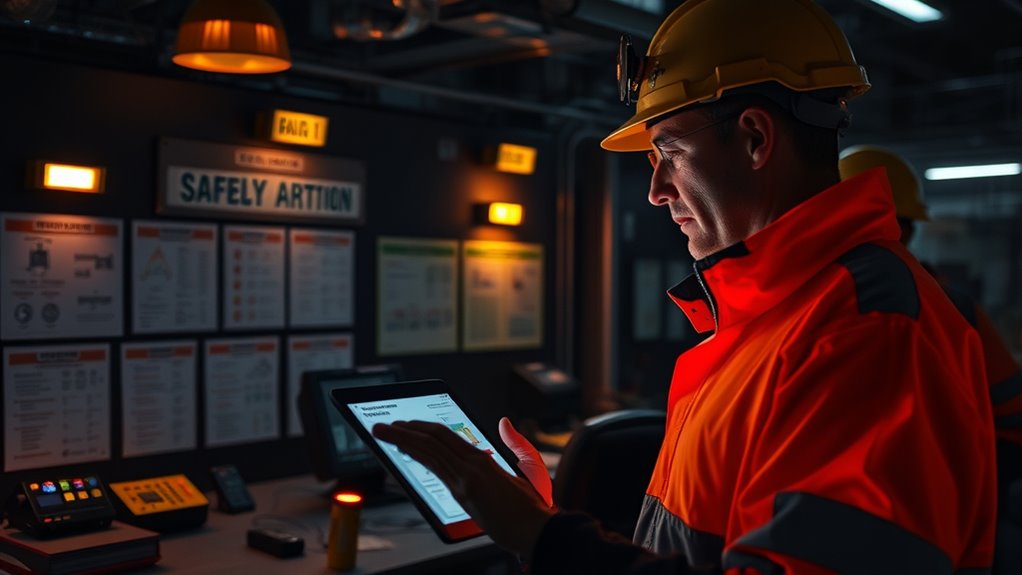
During a power outage, you need to establish clear safety protocols to protect everyone. Make certain essential equipment is secured and ready for use if needed. Also, communicate emergency plans clearly and prioritize assistance for vulnerable individuals to ensure everyone’s safety. Being aware of trust issues that may arise can help in managing the situation calmly and effectively.
Secure Essential Equipment
When a power outage occurs, securing essential equipment quickly becomes crucial to maintaining safety and preventing damage. You need to act swiftly to protect sensitive devices and indispensable systems. First, shut down or unplug equipment like computers, servers, and medical devices to prevent power surges when electricity returns. Second, confirm backup power sources, such as generators, are ready and properly connected. Third, verify that fire and security systems are operational and have backup power if possible. Lastly, protect critical appliances with surge protectors, and avoid opening refrigerators or freezers unnecessarily to preserve cold temperatures. By taking these steps, you minimize risks, safeguard important equipment, and keep your environment safe during the outage. Quick, deliberate actions are key to maintaining safety and preventing damage.
Communicate Emergency Plans
Effective communication is essential to guarantee everyone knows what to do during a power outage. Clear, concise messages help prevent confusion and ensure safety. Use multiple channels like loudspeakers, text alerts, or email notifications to reach everyone quickly. Assign specific roles so each person understands their responsibilities. Regularly update staff and visitors on the situation and safety procedures. To organize your communication efforts, consider this plan:
| Method | Purpose | Responsible Person |
|---|---|---|
| Public Announcements | Inform everyone immediately | Safety Officer |
| Text Alerts | Send quick updates | Communications Team |
| Staff Meetings | Clarify procedures | Managers |
| Signage | Provide visual instructions | Facility Staff |
This structure ensures everyone stays informed and acts swiftly during a power outage.
Prioritize Vulnerable Individuals
Prioritizing vulnerable individuals during a power outage is essential to guaranteeing their safety and well-being. These individuals may include the elderly, children, those with medical conditions, or people with mobility challenges. You should create a plan to check on them regularly and ensure they have access to necessary supplies. Keep a list of contacts for emergency services and caregivers. Assure they have backup power sources for medical devices or other critical equipment. Communicate your plan clearly and in advance.
- Identify at-risk individuals in your community or household
- Arrange for someone to assist or check on them regularly
- Stock up on extra supplies like batteries, medications, and water
- Keep a list of emergency contacts and medical information handy
Planning for Special Needs and Vulnerable Individuals
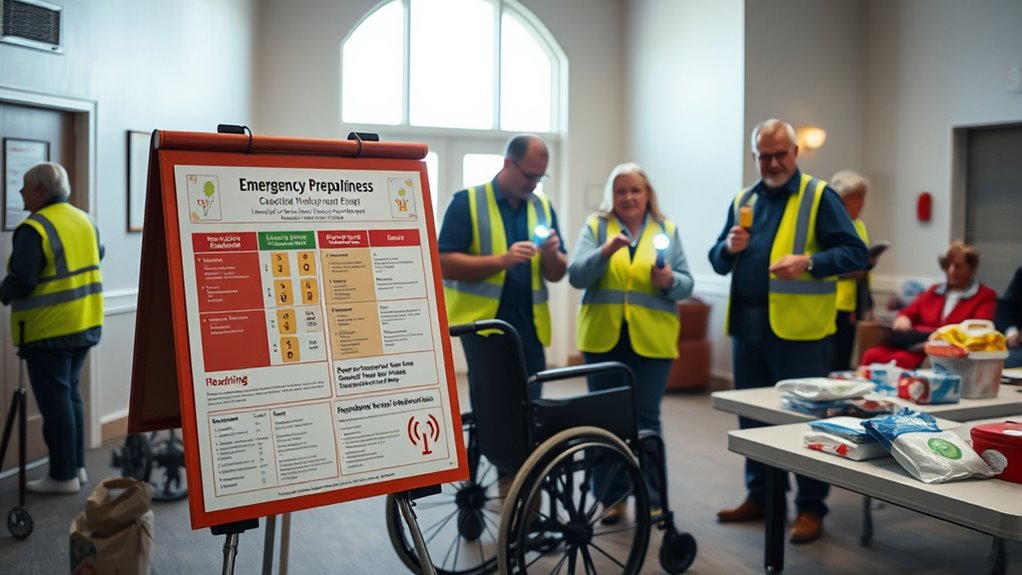
Planning for special needs and vulnerable individuals is a critical component of any emergency action plan, especially during power outages. You need to identify those who require extra assistance, such as medical devices or mobility support. Make sure you have up-to-date contact information and personalized emergency plans for each individual. Prepare backup power sources, like batteries or generators, and ensure they’re accessible. Educate everyone involved on their specific needs and response procedures. Use the table below to organize key information:
| Person | Special Needs | Emergency Contacts |
|---|---|---|
| Jane | Medical equipment | Family, caregiver |
| Tom | Mobility aid | Neighbor, doctor |
| Sarah | Hearing impairment | Emergency services |
| Leo | Medical meds | Pharmacist, family |
| Emma | Cognitive challenges | Support network |
Coordinating With Utility Providers and Local Authorities
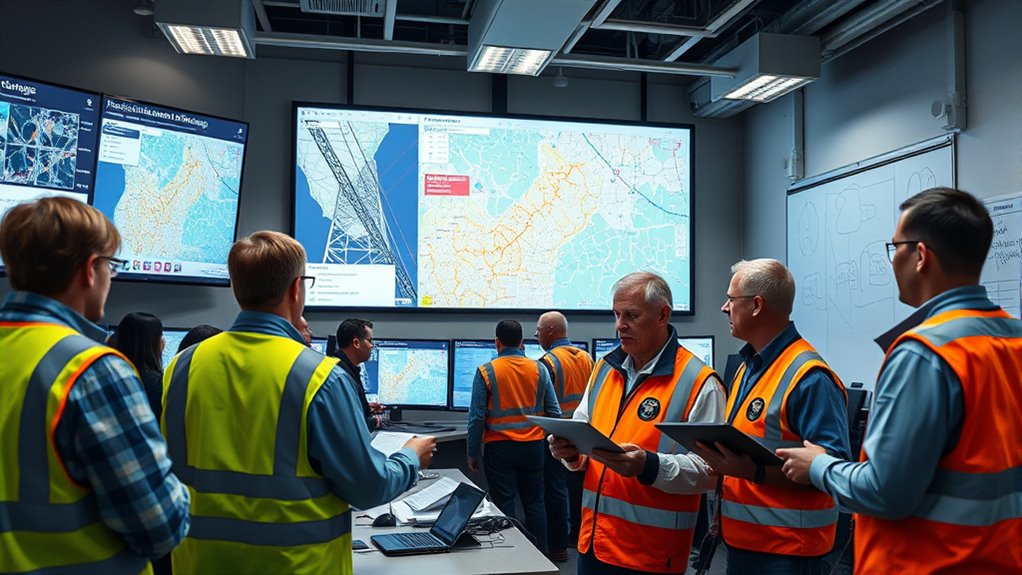
You need to establish clear communication channels with utility providers and local authorities before a power outage occurs. Sharing your emergency plans guarantees everyone stays informed and prepared. This coordination helps facilitate faster responses and minimizes disruptions during an outage.
Establish Communication Channels
Establishing clear communication channels with utility providers and local authorities is essential for a swift and coordinated response during power outages. By setting up reliable contact methods, you ensure quick updates, accurate information sharing, and effective problem-solving. You can prevent confusion and delays that may worsen the situation. Make sure you have multiple ways to reach key contacts, such as phone numbers, emails, and emergency apps. Keep a dedicated list of contacts handy and regularly update it. Test your communication systems periodically to confirm they work. This preparation helps you stay informed and respond promptly, minimizing disruption.
- Maintain a list of utility and local authority contacts
- Use multiple communication methods for redundancy
- Schedule regular tests of your contact systems
- Keep emergency contact information accessible at all times
Share Emergency Plans
How can sharing your emergency plans with utility providers and local authorities enhance your response during power outages? When you share your plans, you create a coordinated approach that guarantees everyone knows their roles. Utility providers gain insight into your specific needs, helping them prioritize repairs or assist if your household faces unique challenges. Local authorities can offer guidance, resources, or support tailored to your situation. This collaboration reduces confusion, accelerates response times, and improves safety for everyone involved. Keeping these organizations informed also helps prevent miscommunication during emergencies. By establishing clear lines of communication and sharing your emergency plans proactively, you foster a stronger community response, ensuring that power outages are managed efficiently and with less disruption.
Conducting Regular Drills and Plan Reviews
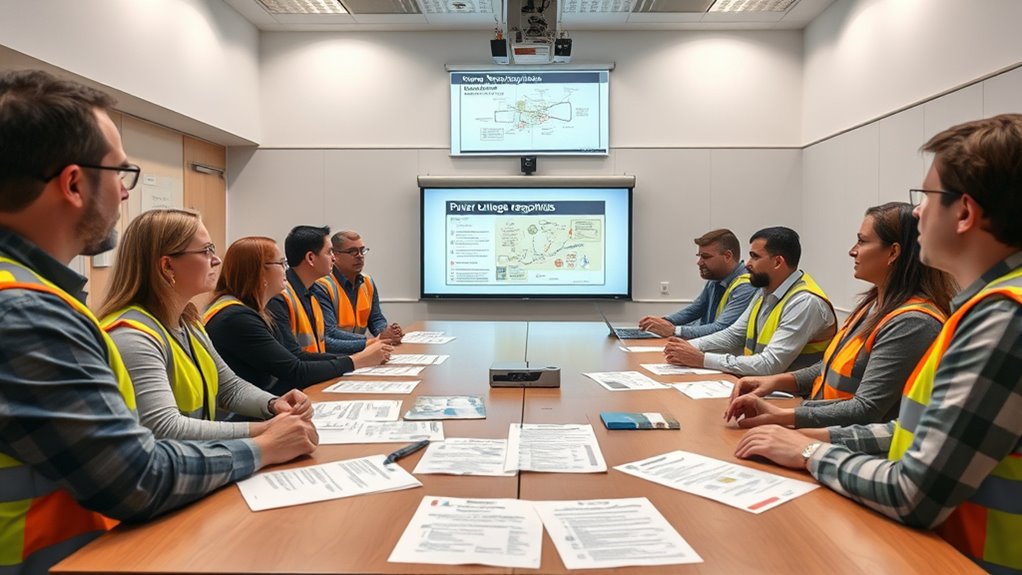
Regular drills and plan reviews are essential to guarantee your emergency response remains effective during power outages. By regularly testing your plan, you identify potential gaps and ensure everyone knows their roles. Conducting these exercises keeps staff prepared, reduces confusion, and improves response times. Review your plan after each drill to incorporate lessons learned and update procedures as needed. Schedule drills quarterly or biannually to maintain readiness. Make sure to involve different teams and simulate real outage scenarios for maximum benefit. Additionally, communicate changes clearly and gather feedback from participants to refine your plan further. Staying proactive with drills and reviews guarantees your team reacts swiftly and confidently when an actual outage occurs. Keep your emergency response sharp and reliable with consistent practice and updates.
- Simulate real outage conditions during drills
- Involve all relevant staff members
- Gather feedback and improve the plan
- Schedule reviews regularly for ongoing effectiveness
Frequently Asked Questions
How Often Should I Review and Update My Emergency Action Plan?
You should review and update your emergency action plan at least once a year to guarantee it’s current and effective. Additionally, update it whenever there are significant changes to your facility, personnel, or procedures. Regular reviews help you identify gaps and stay prepared for unexpected events. Practice drills also reinforce your plan’s effectiveness, so schedule them periodically to keep everyone ready and confident in their roles during an emergency.
What Are Common Mistakes to Avoid When Preparing for Power Outages?
When preparing for power outages, you should avoid common mistakes like neglecting to create a plan, underestimating the duration, or not informing everyone involved. Don’t overlook testing your backup systems or failing to stock essential supplies. You might also forget to update your plan regularly or ignore safety precautions. Stay proactive, communicate clearly, and rehearse your procedures to ensure you’re fully prepared and minimize disruptions during an outage.
How Can I Ensure My Communication Plan Remains Effective During an Outage?
You can keep your communication plan effective during an outage by testing it regularly, ensuring everyone knows their roles. Use multiple methods like phone calls, texts, and social media to reach everyone. Keep emergency contacts updated, and store backup batteries or chargers. Stay informed about the outage’s status through reliable sources, and communicate clearly and frequently. This way, you’ll maintain strong lines of communication when it matters most.
Are There Specific Safety Measures for Large Businesses During Power Loss?
During a power loss, your priority is safety. You should implement clear evacuation procedures, guarantee all staff know emergency exits, and shut down sensitive equipment safely. You also need to communicate promptly, provide backup lighting, and keep emergency contact information accessible. Regular drills reinforce these measures, helping your team respond calmly and efficiently. Preparing in advance minimizes risks, protects your employees, and maintains business continuity during unexpected outages.
How Do I Coordinate Emergency Plans With Neighbors or Community Groups?
You should start by reaching out to neighbors and community groups to share your emergency plans. Organize meetings to discuss common safety procedures, resource sharing, and communication methods. Establish a contact list, set up a neighborhood watch, and agree on roles during emergencies. Keep everyone informed through phone trees or messaging apps. Collaboration guarantees everyone stays safe, prepared, and can quickly respond to power outages or other crises.
Conclusion
By weaving these emergency plans into your daily routine, you’ll turn chaos into calm, like a lighthouse guiding ships safely ashore. Prepare, communicate, and practice—think of it as building a sturdy shield around your home. When the unexpected strikes, your readiness will shine brighter than a beacon in the night, guiding you through the dark with confidence and calm. Stay vigilant, stay prepared, and let your plans be the steady anchor in any storm.
